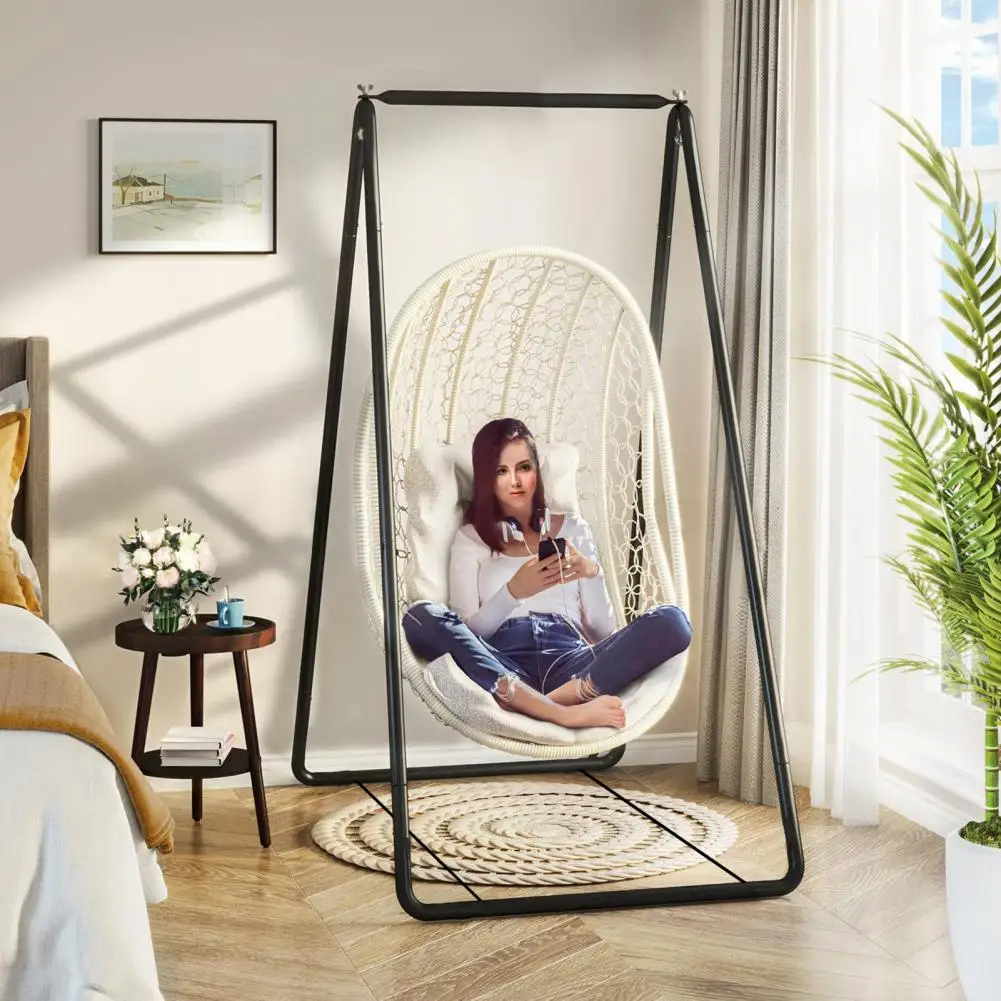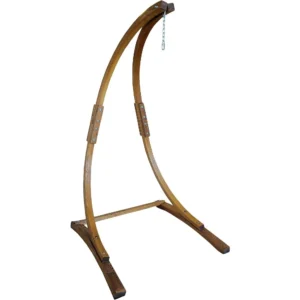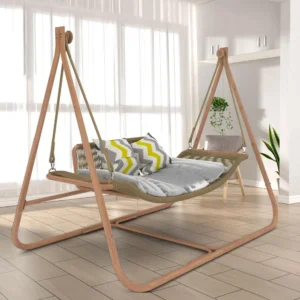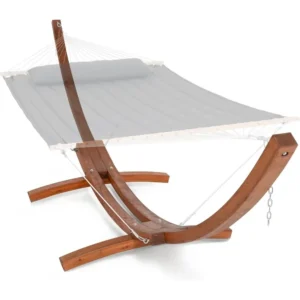Understanding Weatherproof Materials for A-Frame Hammock Stands
When shopping for an A-frame hammock stand that can withstand the elements, it’s important to understand what “weatherproof” actually means. Unlike terms such as “weather-resistant” or “all-weather,” true weatherproofing offers comprehensive protection against multiple environmental challenges.
Outdoor hammock stands face a barrage of elements that can compromise their integrity over time. Rain causes rust and rot, ultraviolet radiation breaks down materials at the molecular level (accounting for about 60% of outdoor furniture deterioration), while humidity, temperature fluctuations, pests, and environmental pollutants all contribute to degradation.
The secret to true weatherproofing lies in two key factors: the inherent properties of the material itself and any protective treatments applied during manufacturing. Some materials naturally resist certain elements—like aluminum’s resistance to rust—while others require special coatings or treatments to enhance their durability.
Your choice of material directly impacts how long your hammock stand will last and how it will perform in your specific environment. Proper indoor and outdoor hammock placement complements your material selection, ensuring optimal longevity and enjoyment.
Understanding these fundamentals helps explain why certain materials perform better in outdoor settings, especially when considering whether leaving your hammock outside is acceptable in your climate. The right material choice can mean the difference between a hammock stand that lasts for decades versus one that deteriorates after just a few seasons.
Premium Metal Options for Weatherproof A-Frame Hammock Stands
Powder-Coated Steel: Durable Strength for All Seasons
Powder-coated steel combines the inherent strength of steel with an advanced protective layer that significantly enhances weather resistance. During the powder-coating process, electrostatically charged powder particles adhere to the metal surface before being cured under heat to form a hard, durable finish.
When properly applied at the recommended thickness of 2-3 mils (0.05-0.08mm), powder coating creates a formidable barrier against moisture and corrosion. This protective shield allows steel hammock stands to withstand years of outdoor exposure while maintaining their structural integrity.
Pros:
– Exceptional stability in windy conditions due to its weight
– Outstanding weight capacity (typically 300-450 pounds)
– Excellent durability with proper maintenance (10-15 years lifespan)
– Affordable compared to many alternative materials
– Wide range of color options for aesthetic versatility
Cons:
– Heavier than aluminum (can be difficult to move)
– Can rust if the protective coating becomes damaged
– Requires periodic inspection for scratches or chips
Understanding proper A-frame hammock stability techniques is particularly important when using steel stands, as their weight provides advantages in certain conditions but may require special consideration during setup and repositioning.
Aircraft-Grade Aluminum: Lightweight Weather-Resistant Performance
Aluminum offers natural corrosion resistance that makes it particularly well-suited for outdoor applications. Unlike steel, aluminum forms a self-protecting oxide layer when exposed to air, creating a natural barrier against further corrosion even if the surface gets scratched.
Premium hammock stands often use aircraft-grade aluminum alloys like 6061-T6 or 7075, which offer an exceptional balance of strength and weight. These stands typically weigh 30-40% less than comparable steel models, making them significantly easier to move around your outdoor space.
Pros:
– Naturally resistant to rust and corrosion
– Excellent for humid or coastal environments
– Lightweight and portable
– Minimal maintenance requirements
– Modern, sleek aesthetic appeal
Cons:
– Generally more expensive than steel options
– Less stability in windy conditions due to lighter weight
– Not as strong as steel (though high-grade alloys minimize this difference)
Anodized aluminum options offer even greater protection and aesthetic appeal, with a hardened surface layer that resists scratches and provides enhanced weather protection.
Marine-Grade Stainless Steel: Premium Corrosion Resistance
For the ultimate in metal durability, marine-grade stainless steel stands as the premium choice. The high chromium content (at least 10.5%, often higher) creates an invisible protective layer that continuously self-repairs when exposed to oxygen, providing unmatched corrosion resistance.
Stainless steel hammock stands come in different grades, with 304 (18% chromium, 8% nickel) suitable for most environments and 316 (“marine grade” with added molybdenum) offering superior protection in coastal or chlorine-exposed settings.
Pros:
– Superior corrosion resistance, especially in coastal environments
– Exceptional durability with 20+ year potential lifespan
– Minimal maintenance requirements
– Premium, modern aesthetic
– Long-term value despite higher initial cost
Cons:
– Highest initial cost among metal options
– Heavy weight affects portability
– May still require occasional cleaning to maintain appearance
The long-term value proposition of stainless steel often outweighs its higher initial cost, especially for permanent outdoor installations where frequent replacement would be inconvenient or expensive.
Natural Wood Options for Traditional Aesthetics
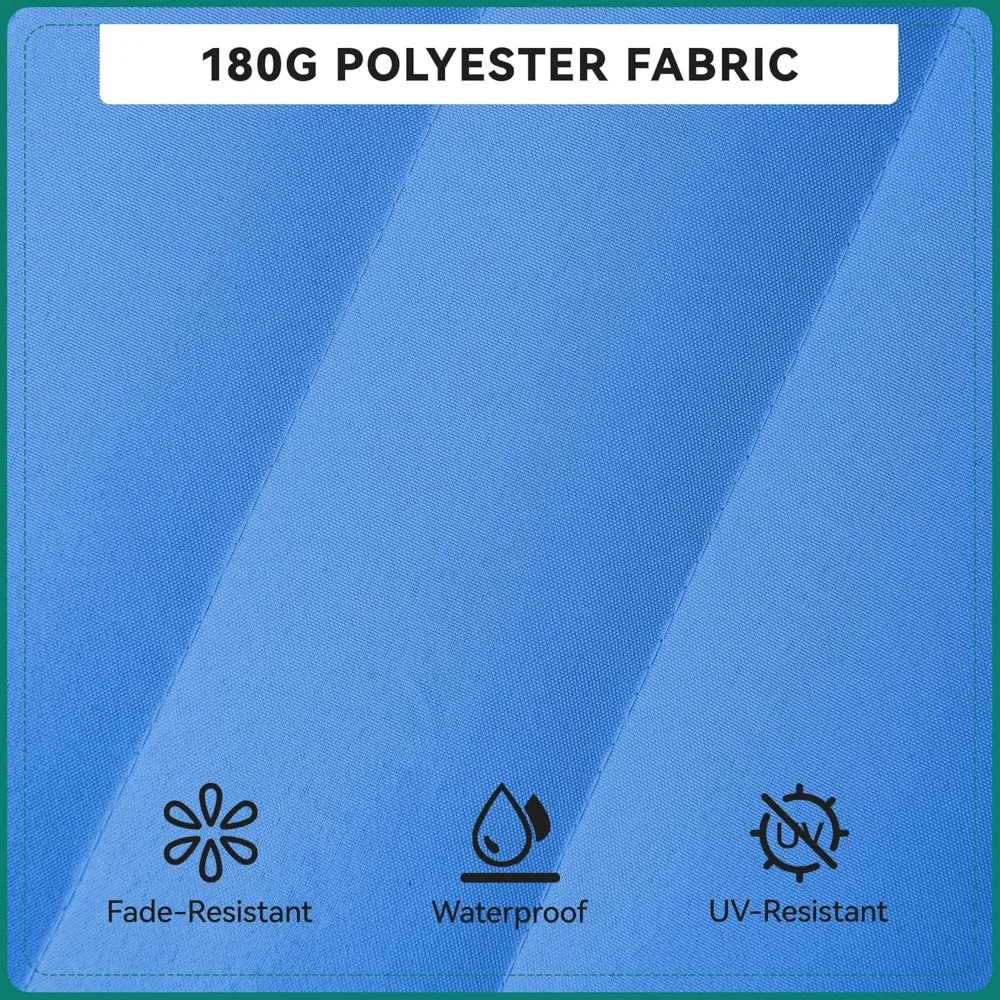
Pressure-Treated Pine and Spruce: Affordable Weather Protection
Pressure-treated lumber offers an accessible entry point into wooden hammock stands with enhanced weather resistance. During the pressure treatment process, preservative chemicals are forced deep into the wood fibers under pressure, creating protection against moisture, insects, and decay.
Modern pressure treatments typically use ACQ (Alkaline Copper Quaternary) or copper azole, which provide effective protection with lower environmental impact than older CCA (Chromated Copper Arsenate) treatments. For outdoor furniture like hammock stands, a treatment retention level of 0.25-0.40 pounds per cubic foot is recommended.
Pros:
– Cost-effective wood option
– Good resistance to insects and fungal decay
– Widely available and familiar material
– Natural appearance that can be stained many colors
– Reasonable 7-10 year lifespan with proper maintenance
Cons:
– Requires regular maintenance (sealing annually or biannually)
– May warp or crack over time with weather exposure
– Less inherent weather resistance than naturally durable woods
– Chemical treatment may be a concern for some users
Our collection of A-frame stand hammock sets includes pressure-treated options that balance affordability with adequate weather protection for most climates.
Cedar and Redwood: Natural Resistance with Classic Appeal
Cedar and redwood contain natural oils and tannins that provide inherent resistance to moisture, insects, and decay without requiring chemical treatments. These woods contain thujaplicins and other natural compounds that repel insects and prevent rot—giving them significant advantages for outdoor applications.
Western red cedar offers a warm, reddish-brown hue that ages to a distinguished silver-gray, while redwood provides a rich, reddish color with remarkable dimensional stability through seasonal changes.
Pros:
– Natural resistance to rot, insects, and moisture
– Beautiful grain patterns and color
– Ages gracefully to attractive patina
– 15-20 year potential lifespan with proper care
– No chemical treatments required
Cons:
– Higher cost than pressure-treated options
– Still requires some maintenance (though less than pine)
– May still weather and change color over time
Many hammock enthusiasts appreciate the option to either seal cedar/redwood to maintain its original color or allow it to weather naturally to an elegant silver-gray patina, offering aesthetic flexibility.
Premium Teak: The Gold Standard for Outdoor Durability
Teak represents the pinnacle of natural wood durability for outdoor applications. This legendary wood contains remarkably high levels of natural oils and rubber content that provide exceptional resistance to water, insects, and rot. These natural compounds remain in the wood for decades, offering protection that no other natural wood can match.
The density and strength of teak make it ideal for load-bearing applications like hammock stands, while its natural golden-honey color weathers to an elegant silver-gray if left untreated—a patina many owners find increasingly beautiful with age.
Pros:
– Exceptional natural weather resistance
– Minimal maintenance requirements
– Beautiful grain pattern and color
– Extremely long lifespan (25+ years even with minimal care)
– Highest prestige value among woods
Cons:
– Highest cost among wood options
– Premium quality teak is becoming more scarce
– Heavier than some other wood options
Our collection of wooden hammock stands includes premium teak options that represent a multi-generational investment in outdoor comfort and style.
Innovative Synthetic and Composite Materials
HDPE Composite Materials: Modern Weather Protection
High-density polyethylene (HDPE) composites represent a modern approach to weatherproof outdoor furniture. These materials combine recycled plastics with stabilizers and colorants to create exceptionally durable products that resist virtually all forms of weather damage.
Unlike wood, HDPE composites won’t rot, crack, or splinter when exposed to moisture. Their UV stabilizers prevent sun damage, and the material maintains its structural integrity through extreme temperature fluctuations from below freezing to intense summer heat.
Pros:
– Nearly impervious to moisture damage
– Excellent UV resistance with minimal fading
– Zero maintenance requirements beyond basic cleaning
– Often made from recycled materials (eco-friendly)
– 15-20 year typical lifespan
– Color options throughout the material (not just surface)
Cons:
– Synthetic appearance may not appeal to natural material purists
– Higher initial cost than some traditional materials
– Can become hot in direct sunlight
The environmental benefits of recycled HDPE composites make them particularly appealing to environmentally conscious consumers looking for sustainable durability.
All-Weather Synthetic Rattan: Stylish Weather Resistance
Synthetic rattan (also called all-weather wicker) combines traditional woven aesthetics with modern weather resistance. Typically crafted from polyethylene (PE) fibers over an aluminum frame, these materials offer the classic look of natural wicker without its vulnerability to weather damage.
Modern synthetic rattan incorporates UV stabilizers that prevent brittleness and color fading, while the material’s imperviousness to water eliminates concerns about mold, mildew, or rot that plague natural wicker.
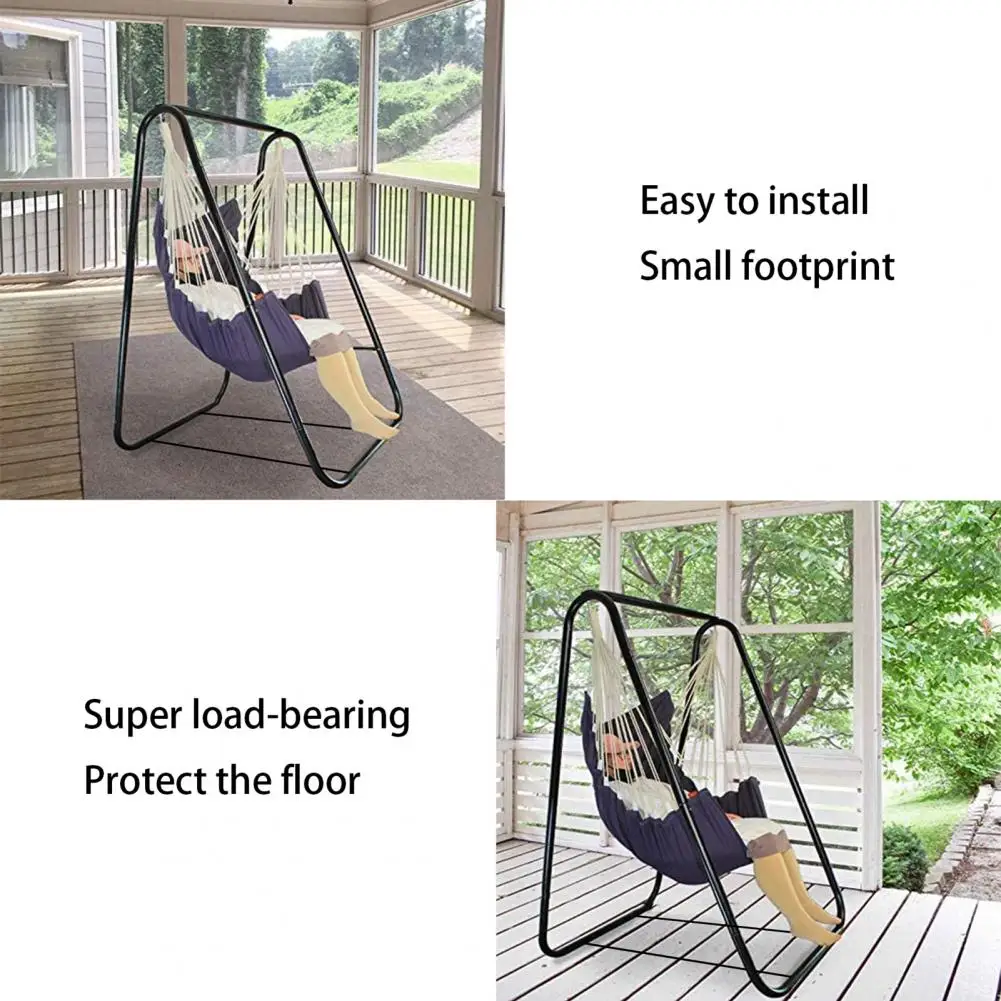
Pros:
– Traditional woven aesthetic with modern durability
– Completely waterproof and UV resistant
– Simple maintenance (just rinse with water)
– Lightweight design for easy repositioning
– 7-10 year typical lifespan
Cons:
– Less structural strength than metal or wood options
– Quality varies significantly between manufacturers
– Premium options can be costly
Synthetic rattan stands often incorporate aluminum frames for structural support, combining the aesthetic advantages of woven materials with the strength of metal construction.
Material Performance Comparison for Informed Decision-Making
When selecting the ideal material for your A-frame hammock stand, comparing key performance metrics helps ensure you make the best choice for your specific needs and environment. The following comparison highlights the relative strengths of each material option:
| Material | Weather Resistance (1-5) | Maintenance Level | Relative Cost | Weight | Aesthetic Appeal | Typical Lifespan |
|---|---|---|---|---|---|---|
| Powder-Coated Steel | 4 | Medium | $$ | Heavy | Modern | 10-15 years |
| Aluminum | 5 | Low | $$$ | Light | Contemporary | 15+ years |
| Stainless Steel | 5 | Very Low | $$$$$ | Heavy | Premium | 20+ years |
| Pressure-Treated Wood | 3 | High | $ | Medium | Natural | 7-10 years |
| Cedar/Redwood | 4 | Medium | $$$ | Medium | Rustic | 15-20 years |
| Teak | 5 | Very Low | $$$$$ | Medium-Heavy | Luxury | 25+ years |
| HDPE Composite | 5 | Very Low | $$$$ | Medium | Modern | 15-20 years |
| Synthetic Rattan | 4 | Low | $$$ | Light | Traditional | 7-10 years |
This comparison illustrates why certain materials command premium prices, while others offer more accessible entry points into weatherproof outdoor furnishings. For those prioritizing long-term value and minimal maintenance, materials like aluminum, teak, or HDPE composites often justify their higher initial investment.
Our heavy-duty hammock sets incorporate many of these premium weatherproof materials, designed to withstand challenging conditions while maintaining their structural integrity and appearance.
Climate Considerations for Material Selection
Your local climate should significantly influence your material selection, as different environments present unique challenges to outdoor furniture durability:
Coastal/High-Humidity Regions:
– Best options: Aluminum, stainless steel (particularly 316 grade), HDPE composites
– Avoid: Standard steel (even with powder coating), untreated woods
– Why: Salt air accelerates corrosion in metals and moisture encourages rot in unsuitable woods
Hot, Sunny Climates:
– Best options: Teak, HDPE composites with UV inhibitors, powder-coated metals
– Considerations: Darker materials absorb heat; lighter colors reflect it
– Why: Intense UV exposure breaks down materials and causes color fading
Rainy Regions:
– Best options: Teak, aluminum, HDPE composites, properly sealed cedar/redwood
– Avoid: Untreated woods, steel without excellent protective coatings
– Why: Constant moisture accelerates rust in metals and rot in susceptible woods
Areas with Extreme Temperature Fluctuations:
– Best options: Aluminum, HDPE composites, stainless steel
– Avoid: Woods prone to expanding/contracting, low-quality synthetics that become brittle in cold
– Why: Material expansion and contraction can cause structural weakening over time
Windy Locations:
– Best options: Heavier materials like steel or teak
– Consider: Additional anchoring systems for lighter stands
– Why: Lightweight stands may tip over in strong winds, potentially causing damage
Understanding these climate-specific considerations helps ensure your investment in an A-frame hammock stand provides the comprehensive weather protection necessary for your unique environment.
Weatherproof Enhancement Treatments and Accessories
Beyond the inherent properties of your hammock stand’s material, various treatments and accessories can further enhance weather resistance:
For Wooden Stands:
– Annual application of marine-grade sealants or UV-inhibiting stains
– End-grain sealers to prevent moisture wicking into wood fibers
– Furniture-grade wax for additional moisture barriers
For Metal Stands:
– Clear protective sprays to reinforce factory finishes
– Touch-up paint kits for powder-coated surfaces
– Paste wax for stainless steel to enhance corrosion resistance
For All Materials:
– High-quality protective covers (ideally 600D polyester with UV inhibitors)
– Proper drainage solutions to prevent standing water around stand bases
– Elevated feet or pads to minimize ground contact and moisture absorption
Anchoring Systems:
– Ground anchors for enhanced stability in windy conditions
– Weight bags for temporary additional stability
– Deck mounting hardware for permanent installations
These enhancements can significantly extend the life of any A-frame hammock stand, particularly in challenging climates or when the stand must remain outdoors year-round.
Essential Maintenance for Long-Term Weatherproof Performance
Even the most durable materials benefit from proper maintenance to ensure maximum longevity:
Powder-Coated Steel:
– Inspect quarterly for scratches or chips in the coating
– Touch up any damaged areas immediately to prevent rust
– Wash with mild soap and water twice yearly
– Apply automotive wax annually for additional protection
Aluminum:
– Clean with mild soap and water as needed
– Remove any built-up dirt or debris twice yearly
– No special treatments required unless anodized (then avoid abrasive cleaners)
Stainless Steel:
– Wash with mild soap and water as needed
– Apply stainless steel cleaner/polish annually
– In coastal areas, rinse salt spray off more frequently
Wooden Materials:
– Inspect annually for signs of weathering or damage
– Reapply sealant or protective finish according to product guidelines (typically 1-3 years)
– Clean with appropriate wood cleaners before refinishing
– Keep clear of soil contact and standing water
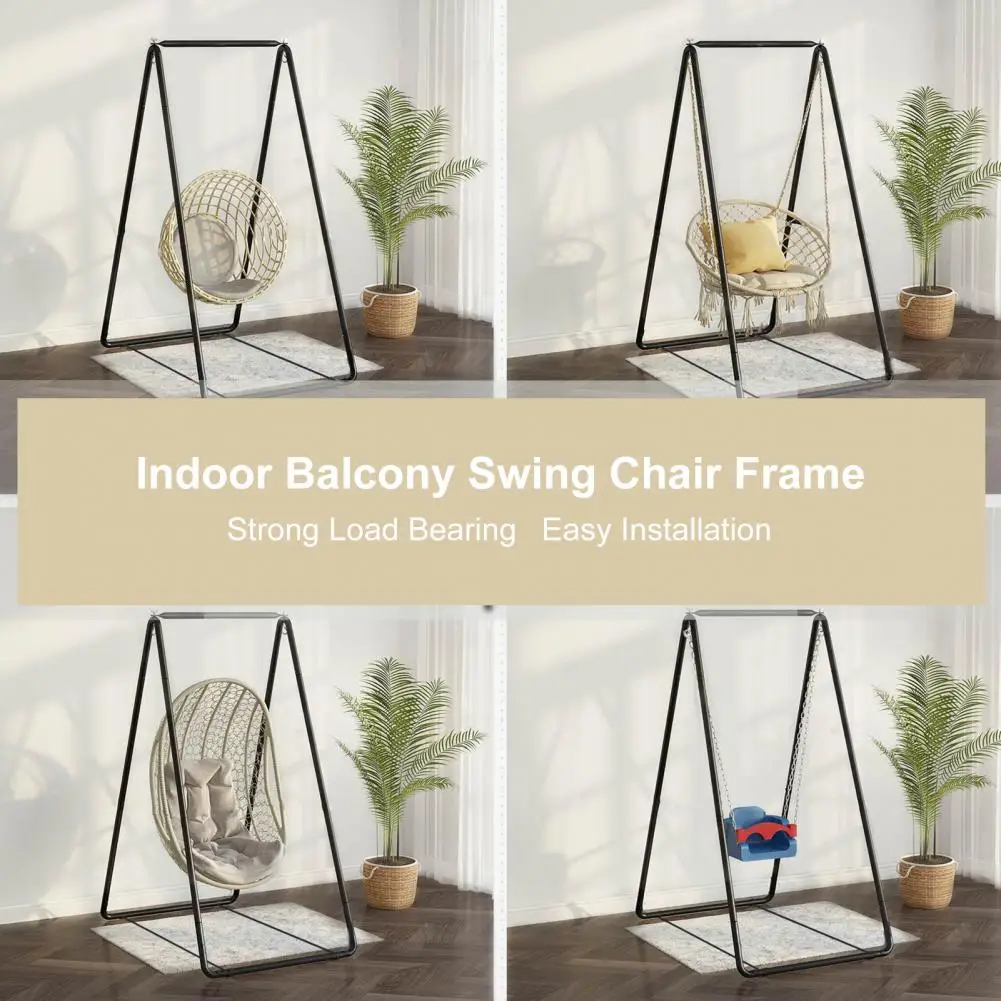
HDPE and Synthetic Materials:
– Rinse with water and mild soap as needed
– Remove leaf debris and pollen that can cause staining
– No special treatments required
Proper hammock installation and safety practices also contribute to material longevity by preventing unnecessary stress on components and connection points.
Dark Wood Hammock Sets, Porch Swing Chair Sets
$653.82 Select options This product has multiple variants. The options may be chosen on the product pageA-Frame Stand Hammock Sets, Swinging Hammock Chair Sets
$154.62 Select options This product has multiple variants. The options may be chosen on the product pageLight Wood Hammock Sets, Swinging Hammock Chair Sets
$1,359.35 Select options This product has multiple variants. The options may be chosen on the product pageClassic Wooden Stand Hammock Sets, Heavy Duty Hammock Sets
$1,061.68 Select options This product has multiple variants. The options may be chosen on the product pageHammock Sets with Canopy, Heavy Duty Hammock Sets
$286.31 Select options This product has multiple variants. The options may be chosen on the product pageHeavy Duty Hammock Sets, Wooden Arc Stand Hammock Sets
$878.66 Select options This product has multiple variants. The options may be chosen on the product page
Frequently Asked Questions About Weatherproof Hammock Stand Materials
Can any A-frame hammock stand be left outside year-round?
Not all materials are suitable for year-round outdoor exposure. Teak, aluminum, stainless steel, and HDPE composites offer the best year-round durability. Other materials may require seasonal storage or protective covers during extreme weather periods. The climate in your region significantly impacts which materials can remain outdoors permanently.
How often should I reseal my wooden hammock stand?
This depends on both the wood type and your local climate. Pressure-treated pine typically requires resealing annually, cedar and redwood every 1-2 years, and teak every 2-3 years (if you choose to seal it at all). In harsh climates with intense sun or frequent rain, increase the frequency. Watch for water no longer beading on the surface—this indicates it’s time to reseal.
Will metal hammock stands get too hot in direct sunlight?
Yes, metal stands can become uncomfortably hot in direct sunlight, with dark-colored metals absorbing the most heat. Aluminum dissipates heat more quickly than steel. Consider placement in partial shade or using lighter colored metals if the stand will be in direct sunlight during hot weather. Wooden stands typically remain cooler to the touch.
What’s the most low-maintenance material option?
HDPE composites and high-grade aluminum typically require the least maintenance. Both can be simply rinsed with water occasionally and require no special treatments or refinishing. Stainless steel is also very low-maintenance but may benefit from occasional polishing to maintain its appearance.
Are there eco-friendly options for weatherproof stands?
Yes! HDPE composites made from recycled plastics offer excellent eco-credentials. For natural materials, look for FSC-certified woods harvested from responsibly managed forests. Cedar and redwood are naturally durable without requiring chemical treatments, making them more environmentally friendly than pressure-treated options.
Our wooden arc stand hammock sets include several eco-conscious options that balance sustainability with durability.
Outside Luxe’s Premium Weatherproof A-Frame Hammock Stand Selection
At Outside Luxe, our material selection process goes beyond industry standards to ensure exceptional durability in our A-frame hammock stands. Each material undergoes rigorous testing for weather resistance, structural integrity, and long-term performance before being incorporated into our product line.
Our quality standards exceed typical industry benchmarks, with particular attention to connection points and stress areas that often fail first in lesser products. For metal components, we use thicker gauge materials and superior finishing processes. For wooden elements, we select only premium grades with optimal grain orientation for maximum strength.
Outside Luxe’s weatherproof testing protocols include accelerated UV exposure, salt spray resistance, and temperature cycling to simulate years of outdoor use in concentrated testing periods. This allows us to confidently stand behind the durability of our heavy-duty hammock sets, knowing they’ll provide years of reliable service in real-world conditions.
By combining premium materials with thoughtful engineering and meticulous attention to detail, our A-frame hammock stands represent the pinnacle of outdoor durability and comfort.

